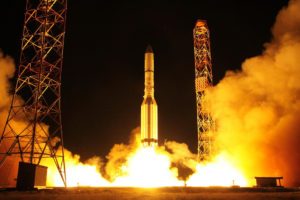
In part three of a three-part feature, Vitaly Egorov describes Russia’s modern posture in space and the challenges and possible ways of development of the national space industry. In this third and final part, Vitaly looks at how commercial alternatives can help fulfill Russia’s space ambitions and honour its heritage.
Commercial Alternative
An alternative strategy for Roscosmos to attract additional financing for space development would be finding both domestic and international commercial customers.
Domestically, Roscosmos can’t boast of many. They are predominantly the oil-and-gas industry sector and the few Russian commercial space businesses in existence. As part of its contract obligations, Roscosmos has had some success implementing certain innovative rocket technology related to propellant transportation. The commercial launch operator Gazprom Space Systems has been the customer for several satellite platforms and rocket launches. The S7 Space Transportation Systems company has recently emerged as a new potential customer with an interest in rocket launches. It has plans to utilize Roscosmos’s future Soyuz-5 rocket to provide launch services to international customers. A small private company called Kosmokurs has plans to commission the development and manufacturing of a light single-stage launch vehicle for suborbital launches.
Expanding its commercial client base must surely be a priority for Roscosmos as a sure means of boosting its earnings and contributing to the national economy. In reality, commercial contracts are usually small-scale, irregular, and have poorly predictable prospects, which is why the state-owned companies that are part of Roscosmos see them as low-priority contracts, preferring to compete for government contracts. Understandably, commercial customers are quite unhappy with this situation and are turning to developing their own production facilities or search for subcontractors from other industries.
Private spaceflight companies could be another type of Roscosmos’ customers in terms of hardware testing and rocket launches, but private spaceflight business is still underdeveloped in Russia. There are less than 10 private space companies currently on the market, and their total investment does not exceed U.S.$100 million (including investment from Russian state venture funds and the business development institutions), the S7 company being the only notable exception. Roscosmos itself makes little effort to help private spaceflight startups to develop. The agency’s top management seems to be only interested in such enterprises that have attracted at least U.S.$100 million of investment and are willing to become a customer of Roscosmos. Technically, Roscosmos isn’t trying to put spokes in the wheel of private emergent space companies, and it even claims its willingness to give them a hand with launching private satellites. But the very procedure of getting a government licence for a space business is constrained by red tape and might take up to three years to obtain. On the other hand, the speedy licensing of the S7 company demonstrates that there must be a ‘back door’ that helps to quickly sort out formalities. But it seems that this ‘back door’ might only open on condition that a hefty U.S.$150 million is invested in the industry and Roscosmos also gets rid of its liability called the Sea Launch, which is currently mothballed in the U.S. and has no rocket launcher to make it useable.
Roscosmos has tried to improve the situation with private space startups by setting up a venture fund in partnership with other Russian national institutes of economic development. The fund was created by direct orders from President Vladimir Putin. Nevertheless, it has little effect for the national space industry as it fails to solve any of the industry’s current issues.
Going to the International Market
So far, orders from international customers have remained the only means of boosting the space industry’s revenue at least by a few dozen percent. Back in 2015 Roscosmos defined rocket launches, rocket and rocket component manufacturing, as well as spacecraft its top market priority in the Federal Space programme through 2025. In other words, the agency stuck with its traditional portfolio and has done little more than setting goals.
The Soyuz-5 is described as Russia’s best bet at ensuring the nation’s triumphal return to the launch vehicle market. It should be noted, however, that nearly all of its launch characteristics are inferior to the current market leader, the Falcon-9. The only thing yet unknown is the price tag. The Soyuz-5 is expected to make its inaugural flight in 2022. The Proton rocket, the former market leader, boasts a quick modernization potential, which allows it to go almost neck and neck with the Falcon-9. However, no such upgrade work is being done at the moment, although the potential had been formulated as early as September 2016. The new Angara rocket, currently in production, has a higher price tag than the Proton and low demand even with the government, which prevents it from enlarging its successful launch portfolio and reduce the manufacturing cost due to the mass production of its stock stage modules it is made up of.
One advantage of the Soyuz-5 is that the S7 company has expressed interest in utilizing it for future launches. In addition to that, Kazakhstan has shown readiness to participate in the joint development of the Baikonur cosmodrome for commercial launches. On top of that, the Soyuz-5 is presented as the core for Roscosmos’s future super-heavy lunar rocket. The design bears similarity to the Falcon Heavy rocket, which is made up of several first stages of the Falcon 9. The fact that the Rocket and Space Corporation Energiya was awarded the contract to develop the Soyuz-5 is an episode of rivalry between it and the Khrunichev Center, which manufactures the Proton and the Angara rockets.
Roscosmos as a Startup
Expanding to new markets is a justifiable priority for Roscosmos. The agency has been trying to carve a niche for itself in the remote sensing and telecommunications markets. In 2017 the Digital Earth project was presented to the general public. Its aim is to provide access to vast satellite image archives and enable users to extract additional data from that imagery, which could then be made available to a wide range of users. So far the project has been implemented in Crimea and the Rostov region, but it is expected to span the whole territory of Russia by 2021. The date of full Earth coverage remains unknown. Russian remote sensing satellites do not have the capability to image the whole planet and using data from other nations’ satellites is not yet in the plans, possibly due to the import substitution policy.
One shouldn’t be too optimistic about the commercial success of Digital Earth as commercial demand for satellite data is quite low in Russia. Moreover, the project has a strong rival in the face of the rapidly growing nation-wide mapping service called Yandex-maps. Besides, modern satellite data services such as Planet cover the whole Earth, including Russia, and are already available in test mode.
The agency’s plan to acquire part ownership of the low-orbit satellite Internet provider OneWeb seems more promising. In return for its stock share, Roscosmos has offered the company to act as a service provider in Russia, and, possibly, to take up manufacturing of some satellites for the constellation and provide launch services. Unfortunately, the attempt was stopped by the Ministry of Telecom and Mass Communications of Russia, which refused to approve the required radio frequencies, citing a need to retain them for its own project of satellite Internet services. It is more likely, though, that this is actually the assertion of interests of the Ministry’s own Russian Satellite Communications Company (RSCC). The RSCC currently operates several geostationary communication satellites and no less than 60% of its users are located in Russia and neighbouring countries. Low-orbit communications are a direct rival to geostationary communications, which makes the Ministry’s plans to preserve its share of the market understandable, even going as far as interfering with Roscosmos’s own plans.
Summary
Russia’s space industry has managed to preserve most of the technological potential of the Soviet Space industry. It is fully capable of performing all state-funded tasks in space exploration, but the range of these tasks has diminished significantly after the end of the Cold War. The current priority of the Russian space programme is retaining its heritage capabilities, which prevents it from developing to its true potential as there is insufficient motivation to justify funding bigger projects. The government has neither the means nor the vision to utilize the space industry to its full capacity. And the industry itself is unable to come up with a new ambitious goal and fails to make a significant input in the national economy, which would justify government funding. Finding private investors is a low-priority task due to the small funding capability of the Russian private business sector.
Technological advancement in other nations leads to the obsolescence of Russian space technology and fewer contracts on the international launch market. Poor financing of space exploration in Russia as well as a lack of both private and nationwide ambitious goals weakens the industry’s human resource capacity. Poor qualification levels of industry specialists causes increased hardware failure rates, which, in turn, further decreases the attractiveness of the space industry for businesses and employers.
The attempts Roscosmos has been making at rectifying the situation are mostly targeting the consequences of the current industry crisis: poor work performance, poor reliability of manufactured goods, low levels of technology development. The space industry is indeed looking for new ways of development, but its efforts do not get the kind of support they should as fighting the current issues is seen as a higher priority.
P.S. While this material was being prepared for publication, an article came out in the major Russian federal newspaper ‘Izvestia’ telling of the Russian government’s plans to integrate Roscosmos with a number of Russian state defence companies. The news is yet to be confirmed officially, but the very fact of this publication and such plans is indicative that the reform of Roscosmos initiated in 2014 must have hit a dead end and its goals were not accomplished. This must be the reason why the space industry is being readied for integration with the defence industry as the latter has made much more significant progress over the last few years in terms of both commercial export and propaganda activity. This merger bodes well for the preservation of the Russian space industry’s current economic and staff capacity. However, the future development of civilian programmes, particularly the manned and the scientific space programmes, may come under threat.

Vitaly Egorov is a PR specialist for the Russian private company Dauria Aerospace. He has a blog under the nickname Zelenyikot, manages the group called Open Space on Facebook and vk.com with the total number of followers exceeding one million, and promotes space exploration in every possible way. He spotted the landing module of the Soviet probe Mars 3 on the Martian surface for the first time and initiated the microsatellite project for taking pictures of the Apollo and Lunokhod landing areas on the Moon.
 SpaceWatch.Global An independent perspective on space
SpaceWatch.Global An independent perspective on space




